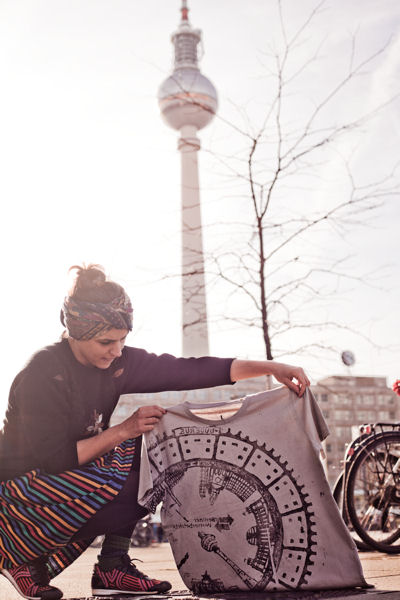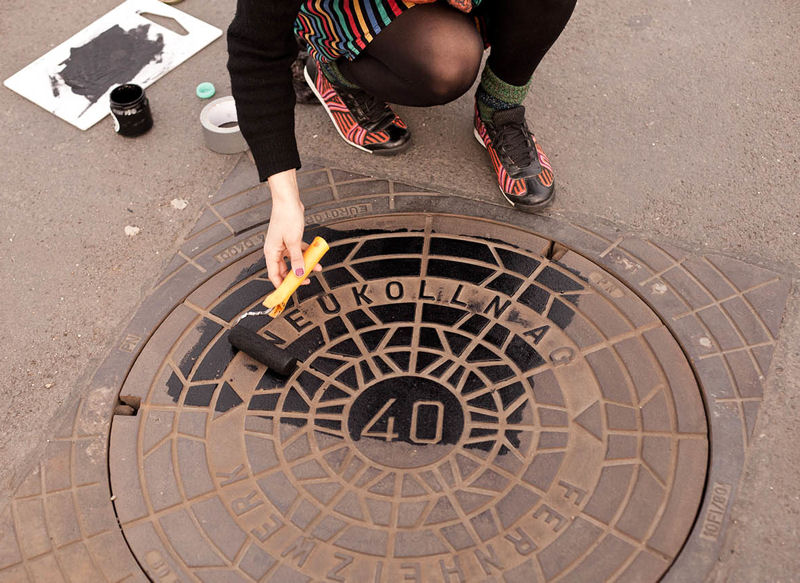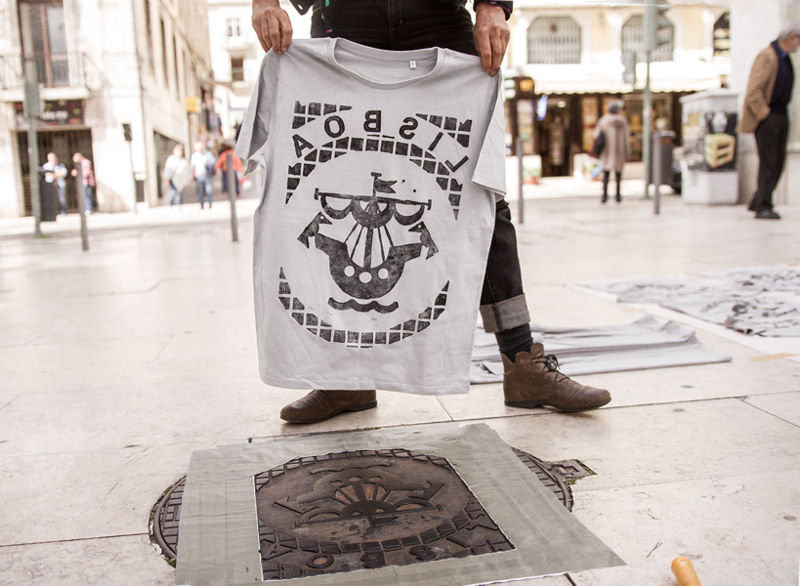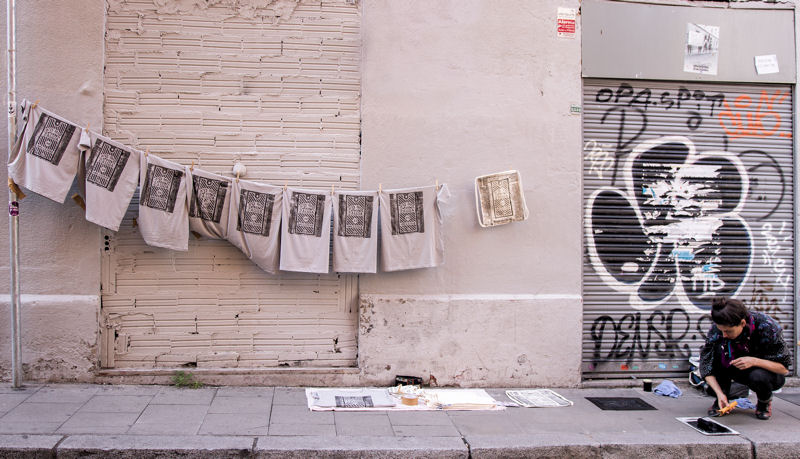Artists from around the world transform manhole covers and wastewater into art

Emma–France Raff, a Berlin textile designer, uses patterns found on manhole covers and other urban surfaces to make art. Photo courtesy of Orpheas Tziagidis, Raubdruckerin.
Some artists look to nature for inspiration. Others explore color, light, or shapes. But a few have found their muse in the municipal wastewater system. One group in Europe is inspired by manhole covers, while another in Taiwan is inspired by the unusual appearance of wastewater samples.
Emma–France Raff, a Berlin textile designer, is arguably one of the world’s leading authorities on manhole covers, having spent a good part of the last decade using them to make art.
Raff is founder and leader of a small community of artists that takes the geometric patterns and typography found on manhole covers, sewer grates, and other urban surfaces and reproduces them on t-shirts, tote bags, and other items. She named the group Raubdruckerin — the feminine form of the German word for “print pirate” — because their designs literally are lifted from the urban environment.

Raff founded Raubdruckerin, a group of artists working to showcase the beauty of urban environments. Photo courtesy of Orpheas Tziagidis, Raubdruckerin.
Since making her first prints more than a decade ago, Raff and her cohorts have visited more than a dozen European cities, including Paris, Madrid, Istanbul, Naples, and Athens, creating more than 1000 prints.
“They are a little part of a community’s identity,” Raff said. “Some are ornamental or have logos or other design elements that distinguish them. They can be quite beautiful.”
The most interesting manhole covers aren’t necessarily the oldest, Raff said. Her portfolio includes prints from manhole covers ranging from 10 to nearly 100 years in age.

The artists take patterns and typography found on everything from manhole covers to sewer grates to make shirts, bags, and other items. Photo courtesy of Orpheas Tziagidis, Raubdruckerin.
It’s more than the manhole covers’ beauty that motivates Raubdruckerin. “Most people don’t notice the small, insignificant details of a city,” Raff said. “We want to draw attention to our surroundings and redefine everyday routines so we all become more sensitive to the beauty hidden in unexpected places.”
For more images, see “The Art of the Sewer” Facebook album.
The next frontier
Now that she has “pirated” manholes across Europe, Raff said she’d love to bring Raubdruckerin to the U.S. Cities on her wish list include New York and Miami. “There are palm trees on Miami’s manhole covers,” she said. “They are very cool.”
Raff also has an answer to an inquiry about the world’s number-one destination for manhole cover connoisseurs. “Japan,” she said without hesitation. “They have the best ones.”

The designs draw community members’ attention to the details of the cities in which they live. Photo courtesy of Orpheas Tziagidis, Raubdruckerin.
Search “Japan manhole covers” to see for yourself. You will discover colorful works of art, featuring everything from diesel locomotives and whimsical space aliens to stylized fish and elaborate cityscapes. They’ve become so popular that an enterprising Japanese company introduced Manhole Cards — similar to baseball cards — with photos of the country’s best manhole covers, along with information that fans use to track down and snap selfies at the original locations of their favorites.
Raubdruckerin has developed something of a cult following as well. People from around the world regularly send Raff photos of their favorite manhole covers. Those who wish to participate in the Raubdruckerin community can start at Raubdruckerin’s website.
Wastewater on a stick
Raff isn’t the only artist to draw attention to sewers in hopes of sharing a larger message.
Early this year, three students at the National Taiwan University of Arts (New Taipei) noticed the dirty water in a canal that runs behind their university. And an idea was hatched.
The students — Hung I-chen, Guo Yi-hui, and Cheng Yu-ti — decided to create art that would raise water pollution awareness in a rather unappetizing way. They collected polluted water samples from all over Taiwan, gathering 100 different varieties to create “Polluted Water Popsicles.”

Taiwanese students created the art display, “Polluted Water Popsicles,” to raise awareness about water pollution. Photo courtesy of the National Taiwan University of Arts (New Taipei), Department of Visual Communication Design.
Yes, popsicles. Made from polluted creek and canal water — including the dirt, bugs, and trash it contained — these repugnant, yet weirdly beautiful “pollution popsicles” were frozen and then encased in polyester resin to preserve them for posterity. The trio made 100 of them, each with a custom wrapper identifying its “flavor,” which was named after the water’s source.
Hung told Quartz, an international business magazine, that she and her classmates chose popsicles because they are visually appealing. Also, their translucence made it easier to showcase the less-than-desirable “additives” found in the wastewater.
Her team’s intent, she said, was to draw attention to the water pollution clogging the nation’s waterways by making it the central ingredient of an otherwise refreshing, mouth-watering treat.
“Such pretty popsicles, would you still want to eat them?” Hung asked.
The “Polluted Water Popsicles” exhibit was displayed at four art exhibitions in the Taipei area in the months since the students created them, and was named a winner of the Young Pin Design Award from Taipei’s Young Designers Exhibition. Stories on the project have since gone viral, appearing in publications worldwide.
— Mary Bufe, WEF Highlights








January 24, 2018
Featured